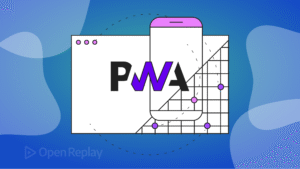People use mobile apps every day — for shopping, banking, learning, or simply staying connected. But not every business can afford to develop, maintain, and update both a mobile app and a website. That’s where PWAs (Progressive Web Apps) come in. They give users the experience of a native app while keeping the convenience of the web.
can afford to develop, maintain, and update both a mobile app and a website. That’s where PWAs (Progressive Web Apps) come in. They give users the experience of a native app while keeping the convenience of the web.
Today, many forward-thinking brands are shifting their focus towards PWAs because they bring native app-like speed, offline support, and push notifications directly into the browser. This is changing how companies approach web design and user engagement. Whether you’re a local business or a growing enterprise, a website development company in Abu Dhabi can now help you deliver mobile-first experiences without forcing users to download anything.
In this guide, we’ll look at what PWAs are, how they work, and why integrating native app features into modern web design for construction is a smart move for any business.
1. What Are PWAs and Why They Matter
A Progressive Web App (PWA) is a type of web application that behaves like a native mobile app. It runs inside a web browser but can be installed on a user’s home screen, work offline, and send notifications — all without being downloaded from an app store.
PWAs combine the best of both worlds — the reach of the web and the performance of an app. They’re responsive, fast, and reliable even with weak internet connections. The best part is that PWAs work across all devices and operating systems.
For businesses, this means reduced costs and a unified user experience. Instead of maintaining separate Android and iOS apps, a single PWA can serve everyone. That’s why many organisations in the UAE are consulting a web designing company in Dubai to explore PWA development as part of their digital strategy.
2. The Rise of App-Like Experiences in Web Design
Users today expect fast, engaging experiences. Traditional websites often fall short when compared to mobile apps that load instantly and offer smooth navigation. PWAs close this gap by integrating native app features into websites.
This shift is not just technical — it’s about meeting user expectations. For example:
- Users want instant access without downloading heavy apps.
- They prefer consistent design across devices.
- They expect websites to work even when the network is poor.
PWAs deliver on all these expectations. A skilled website development company in Abu Dhabi can design PWAs that mimic app functionality while maintaining a familiar web layout. The result is a site that feels fast, modern, and built for today’s users.
3. Key Native App Features Integrated into PWAs
Modern PWAs integrate several native app features that redefine how users interact with websites. Let’s look at some of the most useful ones:
a. Offline Functionality
Traditional websites stop working without an internet connection. PWAs use service workers — background scripts that store essential files — to let users access pages even when offline. For example, users can read saved content, check order histories, or view cached data.
This is especially helpful for businesses in areas with unstable connectivity, making it a valuable feature for clients working with a website development company in Abu Dhabi.
b. Push Notifications
Push notifications are one of the strongest native app features now available on the web. PWAs can send alerts directly to a user’s device, even when the browser is closed. Retailers use them for promotions, news sites for updates, and service providers for reminders.
It keeps users engaged and brings them back to your site — a function once exclusive to mobile apps.
c. Home Screen Installation
PWAs can be added to the home screen of a smartphone just like an app. This reduces the barrier to re-entry — users don’t have to remember your web address. A simple icon tap brings them back.
For businesses, this boosts user retention. When a web designing company in Dubai develops a PWA, it often includes this feature to improve long-term engagement.
d. Background Synchronisation
PWAs can perform updates in the background without interrupting the user. Data is synced automatically, meaning your users always get the latest information when they return online.
This creates a smooth and efficient browsing experience, similar to what users enjoy on native apps.
e. Fast Loading Speeds
PWAs are built to load fast, even on slower networks. Cached data ensures pages open quickly after the first visit. This not only improves usability but also boosts search rankings — a crucial advantage for any business trying to grow online.
4. Why Businesses Are Moving Towards PWAs
There are several reasons why PWAs are gaining attention from brands and web developers alike.
a. Reduced Development Costs
Instead of creating separate Android, iOS, and web versions, one PWA works everywhere. This reduces development and maintenance costs while ensuring consistency.
b. Improved User Experience
PWAs are smooth, responsive, and reliable. They reduce bounce rates and improve engagement, leading to higher conversions.
A professional website development company in Abu Dhabi can help craft PWAs that deliver app-like experiences without technical complexity.
c. Better SEO Performance
Since PWAs are built with standard web technologies (HTML, CSS, JavaScript), they are fully crawlable by search engines. Unlike traditional apps, PWAs can appear in search results — improving visibility and traffic.
d. No App Store Dependency
Publishing apps on iOS or Android requires approval and compliance with store guidelines. PWAs skip that process — users simply visit the website and install it directly.
For many businesses, this independence is a major advantage.
5. Integrating Native App Features into Web Design
Now that we know what PWAs are and why they matter, let’s explore how to integrate native app features into your web design.
a. Mobile-First Design Approach
PWAs thrive on mobile-friendly design. This means starting with small screens and scaling up for larger devices. Responsive layouts, touch-friendly buttons, and adaptive images are crucial.
A web designing company in Dubai that understands user flow can ensure the design feels natural, just like a native app.
b. User-Centric Navigation
App-like navigation is essential. Menus should be clear, animations should feel smooth, and pages must load without reloading the entire site. Tools like React, Angular, and Vue.js help developers build dynamic user interfaces.
c. Performance Optimisation
PWAs rely heavily on speed. Developers use caching strategies and lazy loading to make sure assets are delivered efficiently. The faster the site, the happier the user.
d. Security with HTTPS
PWAs must run on secure connections. HTTPS protects users’ data and builds trust — especially for e-commerce and service platforms. It also helps with better search rankings.
e. Integration with Device Features
Modern browsers allow PWAs to access device features such as cameras, GPS, and file systems. For example, a restaurant app can allow photo uploads, while a fitness brand can use location tracking for workouts.
Integrating these native app features brings your web design closer to what users expect from standalone mobile apps.
6. How a Website Development Company in Abu Dhabi Can Help
Not every business has the technical expertise to develop PWAs internally. This is where professional help becomes essential.
A website development company in Abu Dhabi can:
- Analyse your business goals and recommend the right PWA strategy.
- Design a user interface that mirrors native apps.
- Implement offline features, push notifications, and secure installation flows.
- Optimise your website for performance, accessibility, and SEO.
With expert guidance, you can launch a PWA that works smoothly on all devices and browsers, providing a mobile-app experience right within your web design.
7. Comparing PWAs with Native Apps
To fully understand the value of PWAs, let’s compare them with native apps across several factors.
| Feature | Native App | Progressive Web App |
| Installation | Requires app store download | Directly from browser |
| Updates | Manual updates needed | Auto-updated in background |
| Offline Access | Supported | Supported |
| Development Cost | High (separate apps per platform) | Single codebase for all |
| Discoverability | Limited to app stores | Search engine visible |
| Performance | Very high | Comparable with optimised design |
| Push Notifications | Supported | Supported (on most browsers) |
| Maintenance | Time-consuming | Easier and cheaper |
PWAs clearly provide a balance between affordability, reach, and user satisfaction. They don’t replace native apps completely, but for many businesses, they’re a practical choice.
8. Examples of Businesses Using PWAs Successfully
Several well-known brands have already adopted PWAs, setting benchmarks for others to follow.
- Twitter Lite: Delivers a full app experience in under 1MB and loads quickly on 2G networks.
- Starbucks: Allows offline ordering, which improves service in low-connectivity areas.
- Uber: Built a lightweight PWA that loads in seconds and works flawlessly on slow networks.
- Pinterest: Saw a 60% increase in engagement after moving to a PWA.
These examples show that integrating native app features into websites improves performance and engagement dramatically. A capable web designing company in Dubai can use these principles for local or regional businesses too.
9. Challenges When Building PWAs
Although PWAs offer many advantages, they also come with certain challenges.
- Browser Compatibility: Not all browsers support every native feature. Developers must test across platforms.
- Limited Hardware Access: While modern APIs improve access, some device features remain restricted for security reasons.
- User Awareness: Many users still don’t know they can “install” a website as an app. Clear prompts help encourage adoption.
- iOS Restrictions: Apple’s support for some PWA functions, like push notifications, came later than Android’s. Developers need to adjust accordingly.
A website development company in Abu Dhabi can help navigate these technical considerations, ensuring smooth functionality across devices.
10. The Future of PWAs and Web Design
PWAs are becoming a major part of modern web design strategies. With more browsers adding support for native app features, the line between apps and websites continues to blur.
As 5G networks expand and user expectations grow, businesses will need to offer faster, more reliable web experiences. PWAs deliver that promise through efficiency and flexibility.
For companies in the UAE, especially those partnering with a web designing company in Dubai, adopting PWAs is not just about keeping up with trends — it’s about offering value, accessibility, and performance to users everywhere.
11. How to Get Started with PWAs
If you’re considering moving towards a PWA for your business, here’s a practical approach:
- Audit Your Current Website
Identify weak areas — speed, responsiveness, offline usability — and note what users complain about most. - Set Clear Goals
Do you want faster load times, more engagement, or reduced app costs? Your goal defines your PWA strategy. - Consult Experts
Partner with a trusted website development company in Abu Dhabi to assess what features best suit your brand. - Start Small
You don’t need to rebuild everything at once. Begin with one key feature, such as push notifications or offline access. - Measure and Improve
Track performance using tools like Lighthouse or Google Analytics. PWAs are easy to refine over time.
12. Commercial Benefits of PWAs for Businesses
a. Higher Engagement
PWAs keep users connected with timely notifications and easy re-access. They feel like apps, which encourages repeat visits.
b. Better Conversion Rates
With fast loading and smooth design, users are more likely to complete actions like bookings or purchases.
c. Wider Reach
Since PWAs work on any browser or device, they help brands reach users who avoid downloading apps due to storage limits.
d. Brand Consistency
Businesses working with a web designing company in Dubai can ensure that the visual design and user flow match across platforms.
e. Maintenance Efficiency
Updates are instant. Once the PWA is refreshed on the server, every user sees the latest version.
13. PWAs in the UAE Market
The UAE’s digital landscape is ideal for PWAs. With high smartphone use and reliable internet, users expect quick and modern experiences.
Businesses in sectors like retail, healthcare, tourism, and education are adopting PWAs to reduce costs and reach more users.
A professional website development company in Abu Dhabi can design custom PWAs tailored to local needs — including multilingual support, right-to-left layouts, and local payment integrations.
14. Why Now Is the Right Time
PWAs are no longer experimental — they’re proven, trusted, and supported by major browsers.
For companies competing online, this is the time to act. Developing a PWA ensures your business stays visible, functional, and user-friendly across all devices.
Whether you’re improving an existing site or planning a new one, integrating native app features through a PWA is one of the most effective decisions you can make.
Conclusion
PWAs are reshaping how businesses think about the web. They bring native app features such as offline access, push notifications, and home-screen installation into modern web design, offering speed and reliability users appreciate.
For companies in the UAE, especially those working with a website development company in Abu Dhabi, PWAs offer a cost-effective way to combine the best aspects of mobile apps and websites.
If your goal is to engage users, improve performance, and stay competitive — it’s time to consider developing a PWA for your brand. Contact your trusted website development experts today and start building a smarter, faster, and more accessible digital presence.
FAQs
-
What makes PWAs different from regular websites?
PWAs are designed to act like mobile apps while running in a web browser. Unlike standard websites, they can work offline, send push notifications, and be installed on a device’s home screen. These native app features make PWAs faster, more engaging, and reliable even with a poor connection.
2.How can a website development company in Abu Dhabi help build a PWA?
A professional website development company in Abu Dhabi can handle everything from planning to deployment. They can integrate native app features such as offline browsing, notifications, and background updates into your website, ensuring it performs well on all devices and browsers. Their expertise ensures a secure, responsive, and user-friendly PWA that aligns with your business goals.
3.Are PWAs suitable for all types of businesses?
Yes. Whether you run an e-commerce platform, educational site, service business, or media portal, PWAs can enhance user experience and engagement. A skilled web designing company in Dubai can customise the design and features to fit your specific business model, providing users with a fast and app-like browsing experience.


